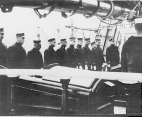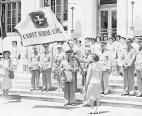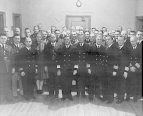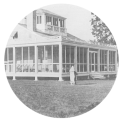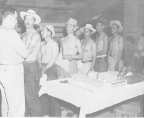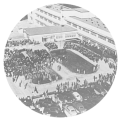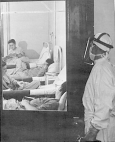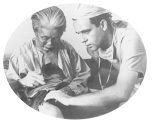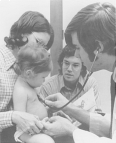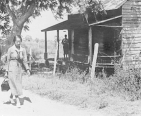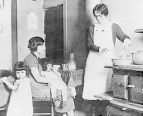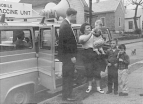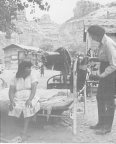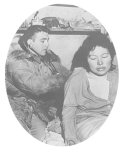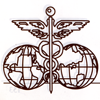 Health Care Delivery
Health Care Delivery
After nearly a century of providing health care to seamen, the mission of the Public Health Service was greatly expanded at the end of the 19th and the beginning of the 20th centuries to include the whole nation.
A Commissioned Corps of highly skilled and mobile health professionals was established in 1889 to work in the hospitals of the Service, to combat epidemics, and to respond quickly to other medical or public health emergencies anywhere in the United States and the world. At first the Corps was composed of only medical officers. Later, laws were enacted to include other health science disciplines.
The task of health care delivery and resource allocation lies primarily in the hands of the Health Resources and Services Administration. This includes supporting states and communities through the National Health Service Corps to plan and deliver health care, especially to people in medically underserved areas, migrant workers, mothers and children, and other groups with special needs; helping to improve the education and distribution of health workers; providing technical assistance for modernizing or replacing health care facilities; and administering the organ transplant program.
The Indian Health Service, which was made a separate agency in 1988, provides comprehensive health services for American Indians and Alaska Natives.
Gallery
Public Health Service officers aboard the Coast Guard Cutter Bear. Since 1879 medical officers of the Service have been assigned to Coast Guard vessels. Many of the early assignments were on expeditions to Alaska, the Arctic, and on training cruises from the Coast Guard Academy. The Bear was built in Scotland in 1873 and was especially designed for navigating through ocean ice. After being acquired by the Federal Government in 1884, the Bear served in the Arctic for nearly 40 years on various rescue, assistance, investigation, and patrol missions.
c. 1915
Presentation of the Cadet Nurse Corps flag to Nurse Director Lucile Petry by Surgeon General Thomas Parran (reading), at ceremonies in Washington, D.C., in June 1944. The need for nurses during the second World War motivated Congress to pass an act in 1943, known as the Bolton Act, for Congresswoman Frances Bolton of Ohio (4th left front) who sponsored the bill in the House, establishing the Cadet Nurse Corps of the Public Health Service. Under the terms of this Act, Federal scholarships in nurse education were made available to qualified young women upon enrollment in schools of nursing whose curricula and nursing facilities met standards prescribed by the Service. Miss Lucile Petry was chosen by Surgeon General Parran as chief of the newly established Division of Nurse Education, which was to administer this program. During its 3 years of existence the Cadet Nurse Corps provided a great reservoir of trained nurses for the military and prevented the collapse of civilian nursing service on the home front.
1944
Sanitary engineers in the Public Health Service during World War II. Since the turn of the 20th century sanitary engineers have played a very important role in the Service by dealing with problems related to water supplies, sewage disposal, industrial wastes, and other environmental hygiene concerns. They have worked to control yellow fever, malaria, and waterborne diseases, such as typhoid fever. The first sanitary engineer was employed by the Service in 1913. Although sanitary engineers had been commissioned in the Reserve Corps of the Service since then, it was not until the Parker Act was passed in 1930 that sanitary engineers were authorized to be commissioned in the regular Corps.
c. 1944
One of the new wooden cottages built around 1923 at the Public Health Service hospital for patients with leprosy or Hansen's disease in Carville, Louisiana (located between New Orleans and Baton Rouge). In 1899 Congress asked the Public Health Service to investigate the origin and prevalence of leprosy in the United States. As the problem became better defined, efforts were made to establish a national leprosarium. In 1921 the Federal Government purchased the Carville Leprosarium from the State of Louisiana for that purpose. Today, the hospital complex is known as the Gillis W. Long Hansen's Disease Center and provides diagnostic, treatment, and rehabilitative services for patients with Hansen's disease.
c. 1968
Public Health Service officer vaccinating Mexican migrant workers, "braceros," in El Paso, Texas. The medical care of migrant workers had been the domain of the Health Services Administration and is now under the aegis of the Health Resources and Services Administration's Bureau of Health Care Delivery and Assistance. The Bureau helps migrant and seasonal farmworkers and their families by funding project grants to State, local, voluntary, public, and private health providers that work with underserved populations. The efforts of Helen L. Johnston and others, which led to the Migrant Health Act of 1962, initiated many of these programs.
c. 1963
Dedication ceremonies in November 1947, marking the opening of the George H. Lanier Memorial Hospital in Langdale, Alabama. This was the first hospital project approved under the Hospital Survey and Construction Act of 1946, also known as the Hill-Burton Act. The Act authorized federal grants to the states to survey their hospitals and public health centers, to plan construction of additional facilities, and to assist in their construction. Federal hospital construction funds were allocated on the basis of population and per capita income, the states with the lower income receiving more per capita than the wealthier states. This program has proved to be very valuable in establishing additional hospital facilities and health centers throughout the country, particularly in rural areas.
1947
Prisoner volunteers, such as these at the U.S. Penitentiary in Seagonville, Texas, were used to test drugs against malaria in the 1940s. The reorganization of the activities of the Federal Bureau of Prisons in 1930 placed the supervision and provision of medical and psychiatric care for federal prisoners in the hands of the Public Health Service. Until then medical care was provided by local physicians.
1948
During the war in Vietnam the Public Health Service provided surgical teams and other forms of medical relief. Here Dr. Gilbert P. Herod attends to a patient suffering from napalm burns in Da Nang.
c. 1968
National Health Service Corps physicians and other health workers have been providing care to families and individuals in medically underserved areas since 1970. The Corps is part of the Health Resources and Services Administration's Bureau of Health Care Delivery and Assistance.
c. 1975
Professionally trained graduate female nurses began to be used more widely in public health hospitals beginning about 1912. Public health nurses were used by the Public Health Service during World War I in camp sanitation work and in special clinics. Their work included general district nursing, tuberculosis nursing, school nursing, infant welfare, visiting in mill villages, emergency communicable disease control, and venereal disease clinic work. Here a public health nurse visits rural patients.
c. 1920
A Public Health Service nurse teaches a mother how to prepare a feeding formula for her infant.
c. 1920
The fight against the spread of communicable diseases through research and immunization programs has always been one of the Public Health Service's major goals. Mobile immunization clinics combined a loudspeaker system with vaccines for hard-to-reach populations.
c. 1955
Public health nurses in the Indian Health Service bring medical care to the reservations. The Indian Health Service provides comprehensive health services to Native Americans and tries to assist tribes in obtaining and using health resources available through federal, state, and local programs. It also serves as the principal federal advocate for American Indians and Alaska Natives in the health field. In 1988 the Indian Health Service was made a separate agency within the Public Health Service with the same rank as other agencies such as the National Institutes of Health and the Food and Drug Administration.
1964
Among the direct beneficiaries of medical care from the Federal Government as specified by law are the Alaska Natives. American Eskimos and other Alaskan tribes receive comprehensive health care including hospital, ambulatory, preventive, and rehabilitative care through the Indian Health Service.
c. 1965



